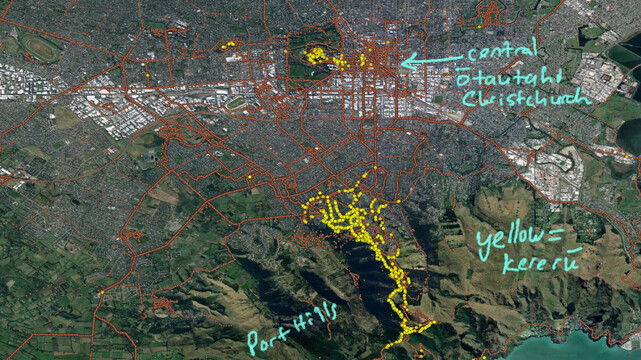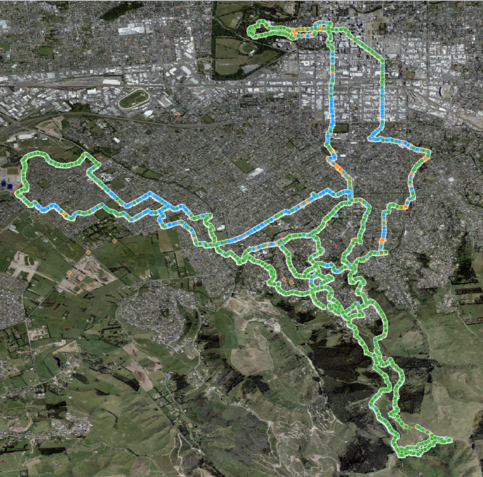Jon Sullivan · @joncounts
988 followers · 2846 posts · Server mastodon.nzToday marks 15 years for my longest fortnightly biodiversity run route.
Each weekend I've been alternating between two 11 km runs, mapping and counting nature along the way (birds, butterflies, etc.). In July 2008 I started my first route, pushing our new baby along in a pram. I added the sister route in Aug. 2008.
I started out simple, counting pre-human native birds and butterflies, on paper. Now I do a heap of things, since I've better ID skills and an iPhone.
Jon Sullivan · @joncounts
905 followers · 2360 posts · Server mastodon.nzToday I hit another milestone in my journey to document nature in my city over my lifetime. After 4-months of R cranking overnight, AWS Transcribe finished transcribing my 833,788 audio notes from my latest 10 years of wild counts. That's 110,735 minutes (77 days) of recordings. Plus my typed observations, that's just pushed me past 1.7 million observations. I've now got serious data cleaning ahead of me before I can release all the data.
Here's a quick taste.
#EcologicalMonitoring #wildcounts
Jon Sullivan · @joncounts
884 followers · 2232 posts · Server mastodon.nzI just uploaded a short article to my WildCounts website about how I count the wild in the rain on an iPhone. I put the phone in a plastic bag, while it's still dry, and then I can reliably tap the screen to start and stop my geotagged and timestamped audio recordings.
Modern smart phones are more water proof and sometimes sort-of-work when wet. The plastic bag trick works a treat always, even with the older phones.
https://wildcounts.org/blog/2018/06/02/How-to-count-the-wild-on-a-smart-phone-in-the-rain
#wildcounts #EcologicalMonitoring
Jon Sullivan · @joncounts
883 followers · 2214 posts · Server mastodon.nzHere's one audio note from a bike ride: "four starlings mid to the west seen then call they flew north off the Burns Building and also five pigeons mid to the west on the Burns Building"
That's my last note transcribed by #AWS Transcribe. I'm in NZ so starlings are Sturnus vulgaris and pigeons are Columba livia. "Mid" means 20–80 m away. "And also" separates two species observations.
#EcologicalMonitoring is *super-easy* for all species that are quick to spot and easy to identify!
#aws #EcologicalMonitoring #wildcounts
Jon Sullivan · @joncounts
883 followers · 2213 posts · Server mastodon.nzLast night I passed another milestone on my long journey to document the changes in nature around me. #AWS Transcribe completed *all* my geotagged and timestamped audio notes from all my bike commutes to and from work. With my weekend runs, that makes 760,840 audio notes transcribed. That's plus 748,707 notes I've typed in over the past 20 years, taking me past 1.5 million. I've got over 500 more trips to transcribe, plus lots of data cleaning still to do.
#aws #wildcounts #nz #EcologicalMonitoring
Jon Sullivan · @joncounts
854 followers · 1585 posts · Server mastodon.nzI'm getting there!
Today I passed a big milestone: I completed transcribing *all* 282,408 audio notes from my weekly biodiversity runs, which I started back in July 2008. Woot!
Now I'm into finishing off my notes from my daily bike rides to work (a route I started recording 20-years ago in March 2003.)
It's all coming together. I'm getting excited about finally pulling together the trends to show everyone, and sharing my cleaned data.
#EcologicalMonitoring #wildcounts #awstranscribe
Jon Sullivan · @joncounts
848 followers · 1545 posts · Server mastodon.nzI passed a milestone this week: **1 million** nature observations in text format.
I'm almost halfway into transcribing my audio notes from my ecological surveys from the past 20 years. While there's data cleaning to do, I can finally see the day coming when I can share it all!
Here's an example AWS Transcribe just processed:
"two monarchs near out left close visiting flowers of a horse chestnut" (17 October 2019, 3:21:36 PM, -43.568987, 172.612719)
#wildcounts #EcologicalMonitoring #nz
Jon Sullivan · @joncounts
844 followers · 1536 posts · Server mastodon.nzHere are some plants I saw along my monthly biodiversity run into the centre of Ōtautahi-Christchurch, NZ.
Liverworts were growing by the footpath on High Street, holly trees are in full fruit (I map out all holly each April, as they spread through the city), a protrate kowhai was in flower, and there's South African boneseed seedlings on Hollis Ave. Boneseed has been spreading up from Bowenvale and into Cashmere hills gardens.
#wildcounts #EcologicalMonitoring #aotearoa #nz #nature
Jon Sullivan · @joncounts
844 followers · 1535 posts · Server mastodon.nzHere are some more things I saw on my Ōtautahi centre city biodiversity run today.
There's a black-morph piwakawaka (fantail), a kererū in the botanic gardens, a little shag drying its wings on the banks of the Avon River in the middle of the city, and one of several monarch butterflies starting to gather into their overwintering parks.
#wildcounts #EcologicalMonitoring #aotearoa #nz #nature
Jon Sullivan · @joncounts
844 followers · 1534 posts · Server mastodon.nzHere are some highlights of my wildcounts biodiversity run into central Ōtautahi-Christchurch this afternoon.
For 4 years now I've been running this monthly 20 km route, between the Sign of the Takahe and Cathredral Square, mapping species along the way. It's the most recent of my standard routes.
Today we've got NZ magpie moth caterpillars (Mokarakara), Australian passionvine hoppers, European wool-carder bees, and a Australian swift spider.
#wildcounts #EcologicalMonitoring #aotearoa #nz
Jon Sullivan · @joncounts
807 followers · 1345 posts · Server mastodon.nzThis is what my computer has been busily doing over the last week. I'm still chuffed that it's working!
Today I'll pass the mark of 50,000 audio notes transcribed in the past eight days. These are all datetime-stamped, geotagged species counts.
These will tell the stories of how nature has changed in the wider Ōtautahi-Christchurch area over the past 20 years. I'm starting with random surveys each month, so the trends will start to emerge soon!
Jon Sullivan · @joncounts
806 followers · 1318 posts · Server mastodon.nzSome things I saw on my bike commute today between Ōtautahi-Christchurch, #NZ, and Lincoln...
> the first fly agaric mushrooms of the season along the route. Bring out your gnomes.
> ~200 Canada geese in a grassed retention basin of a new housing subdivision. That's ~200 more geese than I saw the first 10 years riding this route.
> an Amphipsalta cicada, always a treat to see close up.
> a roadkill kahukura-red admiral butterfly. Cars kill butterflies as well as birds.
Jon Sullivan · @joncounts
801 followers · 1275 posts · Server mastodon.nzHere are a few maps from my biodiversity runs this week through Ōtautahi-Christchurch. I've just processed my audio notes through AWS Transcribe.
As usual, native forest birds are mostly in the Cashmere hills and Wigram Retention Basin and Botanic Gardens (i.e. the forest). Gulls like the city centre.
Passionvine hoppers and steelblue ladybirds are Australian species spreading south as the climate warms. They're mostly in the hills on my routes.
#EcologicalMonitoring #wildcounts #nz #aotearoa
Jon Sullivan · @joncounts
776 followers · 1072 posts · Server mastodon.nzZoom can't stop the monitoring!
Ecological monitoring is easy, and important, and so I do it all the time. Here are my hand-written notes while on a Zoom meeting earlier today at home, which I just typed into my computer.
When I'm at an office with a window open, I always note down the endemic NZ forest birds and butterflies and cicadas, in 20 minute intervals.
During my Zoom meeting, there was lots of korimako-bellbird song.
https://wildcounts.org/blog/2018/06/02/Seven-years-of-bird-counting-from-my-office/
#EcologicalMonitoring #wildcounts
Jon Sullivan · @joncounts
627 followers · 556 posts · Server mastodon.nzIn 2022, I added flax notcher and scraper moth damage to the species I map along my standard runs through Ōtautahi-Christchurch. The caterpillars make distinctive damage on flax leaves (as I first learned in high school). In hindsight, this was crazy to try to map while running, but the results are fascinating! Flax cultivars are now widely planted in gardens, but almost all of the herbivory is on the old flax up in the hills.
#EcologicalMonitoring #WildCounts #Phormium #AotearoaNZ #Herbivory
#EcologicalMonitoring #wildcounts #phormium #AotearoaNZ #herbivory
Jon Sullivan · @joncounts
624 followers · 533 posts · Server mastodon.nzHere are all the piwakawaka (fantails) and riroriro (grey warblers) I saw and heard in 2022, along my standard run routes through Ōtautahi-Christchurch. For both, with very few exceptions, they are where the forest is. They're fast breeding birds that can handle some predation by mammals, but they like dense, tangled forest to feed in and hide in. If we want more of these birds in Ōtautahi, we'll need more forest.
#EcologicalMonitoring #WildCounts #Birds #AotearoaNZ #Gerygone #Rhipidura
#EcologicalMonitoring #wildcounts #birds #AotearoaNZ #gerygone #rhipidura
Jon Sullivan · @joncounts
624 followers · 527 posts · Server mastodon.nzHere's all the kererū I saw in 2022 along my standard run routes through Ōtautahi-Christchurch. Kererū are large fruit & leaf eating forest pigeons. They're most common in native bush of the Port Hills, plus enjoy the fruit of all the wild poroporo that's grown up after the fires. They venture into the suburbs at the base of the hills, especially when garden plums are fruiting. Also, some now breed in the Botanic Gardens!
#EcologicalMonitoring #WildCounts #Birds #AotearoaNZ #kererū #Hemiphaga
#EcologicalMonitoring #wildcounts #birds #AotearoaNZ #Kereru #hemiphaga
Jon Sullivan · @joncounts
621 followers · 516 posts · Server mastodon.nzHere's a map of all the miromiro (tomtits) I saw and heard in 2022 along my standard run routes through Ōtautahi-Christchurch. Miromiro are endemic insectivorous forest birds, and much more common deeper into Banks Peninsula. The only place along my standard city run routes that I've ever heard or seen them is in the original native forest of Sugarloaf. There's nothing like the real thing when it comes to native forest.
#EcologicalMonitoring #WildCounts #Birds #AotearoaNZ #miromiro #Petroica
#EcologicalMonitoring #wildcounts #birds #AotearoaNZ #miromiro #petroica
Jon Sullivan · @joncounts
617 followers · 509 posts · Server mastodon.nzHere's map of all the korimako (bellbirds) I saw and heard in 2022 along my standard run routes through Ōtautahi-Christchurch. Korimako are endemic forest birds that are common in the forests and hill suburbs of Port Hills. They're also now well established in the Christchurch Botanic Gardens, and have recently settled into the planted tree patches in the Wigram Retention basin area. They remain rare in the flat suburbs.
#EcologicalMonitoring #WildCounts #Birds #AotearoaNZ #bellbird #korimako
#EcologicalMonitoring #wildcounts #birds #AotearoaNZ #Bellbird #korimako
Jon Sullivan · @joncounts
617 followers · 508 posts · Server mastodon.nzIn 2022 I managed to transcribe all my wild counts from my weekly and monthly runs, thanks to the magic of #AWS Transcribe. In total, I made 62,015 audio notes (166 hours of talking) while running 1,095 km along my standard transects through Ōtautahi-Christchurch, NZ. I count+map birds, butterflies, and a large assortment of plants, insects, herps, mammals, and fungi (AKA #biodiversity). I'll post some 2022 maps through the week.
#EcologicalMonitoring #WildCounts #AotearoaNZ #biodiversity
#aws #biodiversity #EcologicalMonitoring #wildcounts #AotearoaNZ


















